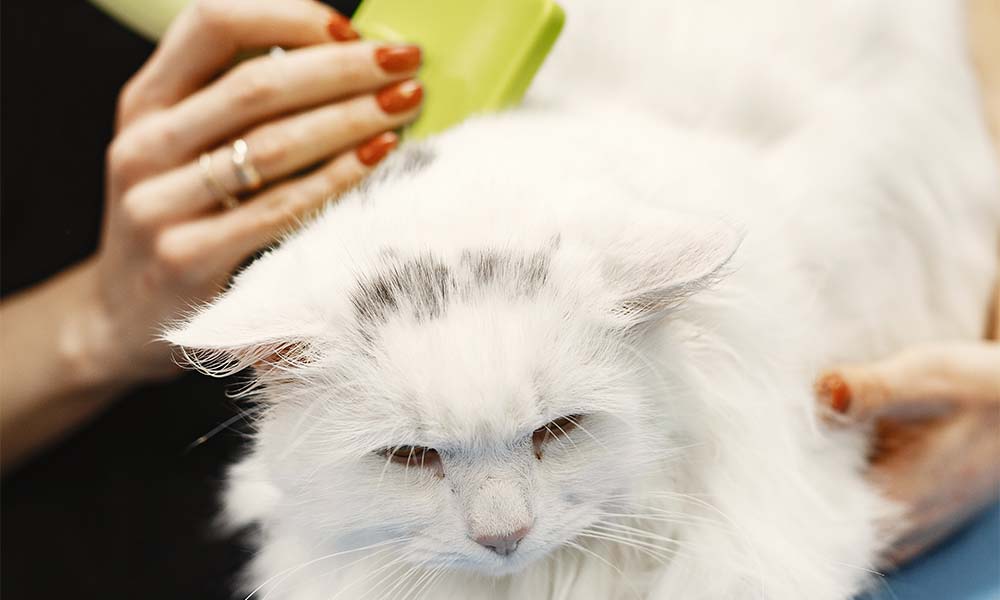For cat owners, cat grooming might seem like a luxury or an unnecessary chore, especially when most cats are known for meticulously cleaning themselves. However, incorporating routine grooming into your cat’s schedule can offer many benefits for you and your feline friend.
Not only does regular grooming help maintain your cat’s coat, keeping it free from knots and tangles, but it also serves as an essential bonding time that can strengthen the connection between you. What’s more, frequent cat grooming sessions allow for the early detection of potential health concerns, such as lumps, parasites, or skin issues.
By prioritising regular cat grooming, you’re not just pampering your pet; you’re contributing to their overall well-being and hygiene, creating a more harmonious living environment for all.
At Cat Castle, your cats never feel abandoned, unlike with pet sitters. Additionally, the stress-free, no-dog boarding means a quieter stay for your cat.
Let’s explore why frequent grooming should be an integral part of your cat care routine.
The Unseen Benefits Of Regular Cat Grooming
For those who might consider cat grooming an afterthought, the tangible benefits it offers your pet are substantial and often go unnoticed until you start practising it regularly.
Preventing Matting and Maintaining Coat Health
A sleek and smooth coat isn’t just aesthetically pleasing; it’s crucial for your cat’s comfort and health. Regular grooming prevents matting, which can lead to discomfort and even skin infections for your cat. Brushing distributes the natural oils in your cat’s skin, ensuring their coat remains healthy and glossy. This routine not only keeps their fur in top condition but also stimulates blood flow to the skin.
Matting can be particularly problematic for long-haired breeds, making daily brushing a necessity. However, even short-haired felines can benefit from regular grooming, as it minimises shedding and helps to avoid potential fur-related complications. Consistent grooming habits ensure that your cat’s coat and skin stay in the best shape possible.
Spotting Health Issues Before They Escalate
Frequent grooming sessions are opportune moments to check for abnormal signs in your cat’s skin or coat. By running your hands through their fur, you’ll quickly notice any lumps, bumps, or wounds that may require veterinary attention.
Early detection of such irregularities is crucial for prompt treatment and can often prevent minor issues from escalating into major health problems.
Moreover, your routine checks can reveal signs of fleas or ticks, which are easier to eradicate when detected early. Regular grooming enables you to monitor your cat’s health closely and take action when anything seems amiss, ultimately saving you from worry and potentially high veterinary bills down the line.
The Bonding Power Of Grooming Your Cat
There’s more to grooming than just the physical benefits, it’s a chance to fortify the emotional bond between you and your cat, turning a routine task into an opportunity for connection.
Establishing Trust Through Touch
Trust is fundamental in the relationship with your feline companion, and grooming offers a perfect opportunity to build it. When grooming your cat, you’re engaging in a physical display of care that can comfort and reassure them.
Over time, as your cat grows accustomed to being handled, they will begin to associate your touch with a positive and calming experience, deepening the trust between the two of you.
Gently brushing your cat’s fur can soothe them and can be particularly beneficial for anxious or rescued cats, who may need extra time and care to settle into their new environment. By making grooming sessions a safe and pleasant time, your cat’s confidence in you will flourish.
Communication Beyond Words
Cats communicate through body language much more than through vocalisation. As you spend time grooming your cat, you learn to understand their non-verbal cues and preferences. This silent communication can help you better cater to your cat’s needs and preferences, tailoring your interactions to suit their comfort levels.
Also, grooming provides your cat with the tactile stimulation that they may seek out. This mimics the natural social grooming behaviour they’d experience in the wild, promoting a sense of well-being and contentment. Through regular grooming, you’ll create a shared routine that signifies trust and well-being for your cat.
Cat Greeting As A Wellness Indicator
Regular cat grooming not only beautifies your pet but also plays a pivotal role in monitoring their well-being, making it a wellness indicator that can’t be overlooked.
Monitoring Skin and Fur Condition
While grooming, you’re in an excellent position to examine the condition of your cat’s skin and fur. A healthy cat’s skin should be free from sores, flakes, or excessive oiliness, while their fur should be smooth and free of debris. Any variations could indicate a health issue that might require further investigation.
Dull fur, for instance, can reflect a deficiency in your cat’s nutrition or a potential underlying health issue. Regular grooming allows you to keep an eye on the condition of your cat’s skin and fur, ensuring you can adapt their diet or seek veterinary advice if necessary.
Detecting Parasites and Preventing Infestation
A significant aspect of grooming is the control and prevention of parasites. Fleas, ticks, and other external parasites can be detected during grooming before they become a significant issue. By thoroughly examining your cat’s coat and skin, you can catch these pests early and take measures to eliminate them.
Consistent grooming can also help in preventing future infestations by maintaining proper hygiene and applying preventive treatments recommended by your vet. A parasite-free cat is a happy and healthy cat, and cat grooming is your first line of defence against these pests.
Practical Tips For Effective Feline Grooming
Grooming your cat doesn’t have to be a struggle. With the right approach and techniques, you can make it an enjoyable experience for both you and your feline friend.
Choosing the Right Tools for Different Coat Types
Not all grooming tools are created equal, and using the right ones for your cat’s specific coat type can make a world of difference. For short-haired breeds, a fine-toothed comb or bristle brush can efficiently remove loose fur and dirt. Long-haired cats may require a wide-toothed comb or a slicker brush to detangle and prevent matting without causing discomfort.
Invest in high-quality grooming tools that are designed especially for cats. These tools should gently care for your cat’s coat without pulling or snagging, making the grooming experience a positive one.
Incorporating Grooming into Your Daily Routine
Consistency is key when it comes to grooming. Incorporate it into your daily routine, setting aside a fixed time each day for a brief grooming session. This helps your cat get used to being groomed and learn to expect it, making them more cooperative over time.
Remember to introduce grooming gradually, especially if your cat is initially resistant. Start with shorter sessions and slowly increase the time as your cat becomes more comfortable. With patience, grooming can become a welcomed part of their daily rhythm.
Handling Sensitive Areas and Making Grooming Pleasant
Cats can be sensitive to touch in areas such as their belly, paws, and tail. When grooming these areas, be especially gentle and watch for signs of discomfort. If your cat becomes agitated, it’s essential to back off and try again later, maintaining trust and comfort as your priorities.
To make the grooming process enjoyable, pair it with positive reinforcements like treats or cuddles. Create a calm environment, and speak in soothing tones to help your cat relax. With the right approach, grooming can become a bonding activity that your cat looks forward to, associating it with feelings of safety and pleasure.
Conclusion
Embracing a regular cat grooming routine can vastly improve your pet’s life, from maintaining a shiny coat to spotting potential health risks early on. Cats live in the now. If you book Cat Castle for your pet’s holiday, whether you’re away for four days or four weeks, they have no comprehension of time.
Cats in our cattery never feel abandoned, unlike with pet sitters. Remember, a well-groomed cat is the hallmark of a conscientious and caring owner who values their pet’s happiness and health.
For more information or to book a stay at Cat Castle, where your cat can have a holiday when you do.
Frequently Asked Questions
Regular cat grooming contributes significantly to your pet’s well-being. It helps distribute the cat’s natural oils across their coat, promoting a healthy shine and skin condition. Moreover, it allows you to spot any potential skin issues, parasites, or abnormalities early on. Grooming sessions can also become bonding experiences, reducing your cat’s stress levels, and can further assist in the reduction of hairballs by removing loose fur.
The frequency of cat grooming sessions can vary depending on your cat’s breed, coat length, and individual needs. For long-haired breeds like Persians or Maine Coons, daily grooming might be necessary to prevent mats and tangles. Short-haired breeds may require less frequent grooming sessions, such as once a week. Pay attention to your cat’s self-grooming habits and adjust your routine accordingly for optimal coat health and hygiene.
Yes, frequent grooming can play a vital role in reducing the incidence of hairballs. As you groom your cat, you remove the excess and loose fur that would otherwise be ingested during self-grooming. A reduction in swallowed hair lessens the likelihood of hairball formation in the digestive tract, contributing to a healthier and more comfortable cat.
Introducing a grooming routine early in a cat’s life is important for several reasons. It acclimates your pet to the sensations and process of being groomed, which can minimise stress and resistance as they grow. Early grooming routine introduction helps establish a consistent schedule that can benefit both you and your cat, ensuring regular coat and skin maintenance from a young age.
For effective home cat grooming, essential tools include a bristle or rubber brush, a fine-toothed comb for removing mats, nail clippers designed for cats, and cat-safe shampoo for occasional baths. Using these tools properly involves gentle, consistent strokes when brushing to avoid hurting your cat’s skin. Regularly check for mats and gently tease them apart with a comb. When trimming claws, avoid the quick to prevent bleeding. If bathing your cat, ensure the water is lukewarm, and the shampoo is thoroughly rinsed to prevent skin irritation. Always follow up grooming sessions with praise and treats to create a positive association.





